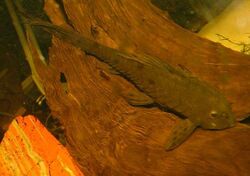Biology:Rhinelepini
| Rhinelepini | |
|---|---|

| |
| Pseudorinelepis genibarbis | |
| Scientific classification | |
| Domain: | Eukaryota |
| Kingdom: | Animalia |
| Phylum: | Chordata |
| Class: | Actinopterygii |
| Order: | Siluriformes |
| Family: | Loricariidae |
| Subfamily: | Hypostominae |
| Tribe: | Rhinelepini Armbruster, 2004 |
| Genera | |
Rhinelepini is a tribe of fishes in the subfamily Hypostominae of the armored suckermouth catfish family Loricariidae.
Taxonomy
This tribe is a well diagnosed monophyletic group currently containing three genera: Pogonopoma, Pseudorinelepis, and Rhinelepis. When the tribe was first described, Pogonopomoides was a valid genus, but it is now a synonym of Pogonopoma.[1] Pseudorinelepis is the most basal, and Rhinelepis and Pogonopoma are more derived sister groups.[2]
Appearance and anatomy
Rhinelepini species are generally medium to large-sized Loricariids. Rhinelepini species are unique among Loricariidae for having a normal, circular iris as opposed to the bilobed, omega iris.[2] These species end to have relatively thick armor plates on their bodies.[2] In Iquitos, Peru, Pseudorinelepis genibarbis is known as carachama sin costilla, which actually means "Loricariid without ribs"; this refers to the trait that it shares with other Rhinelepini catfish; members of this tribe do not have ribs past the sixth vertebra.[3]
One of the characters that binds this group together is a large U-shaped diverticulum of the digestive tract; this is always filled with air.[2][4] The first part of the diverticulum is modified from the esophagus and consists of thick musculature; this passes a short distance before reaching the second, main, U-shaped part of the diverticulum. In Rhinelepis and Pseudorinelepis, the diverticulum functions as an accessory respiratory organ. In Rhinelepis, the diverticulum is more attached to the abdominal wall and the interior of the diverticulum is more textured. In Pogonopoma, the diverticulum is similar to a swim bladder and may be used as a hydrostatic organ; the first part of the diverticulum is greatly reduced and the second part is larger and has a smooth interior surface and less vascularized.[4]
Distribution
The tribe Rhinelepini has an interesting biogeography and reveal information about the aquatic systems of South America. There is a split between the species that inhabit Amazon and those that inhabit the eastern river systems. Pseudorinelepis, the most basal group, is found only in the Amazon basin. Pogonopoma, is found in the Mucuri, Paraíba do Sul, and Uruguay River systems in southeastern Brazil . Rhinelepis is found in São Francisco River and Paraná River. It is also thought to have spread through to the Paraíba by a sharing of its headwaters with the Paraná in the past, which eventually got separated into two basins.[1][2]
The oldest group, Pseudorinelepis, inhabits the Amazon area, while the distribution of the newer, more derived groups occurs in Southern Brazil, which is comparatively older.[1]
References
- ↑ 1.0 1.1 1.2 Quevedo, Rodrigo; Reis, Roberto E. (2002). Schaefer, S. A.. ed. "Pogonopoma obscurum: A New Species of Loricariid Catfish (Siluriformes: Loricariidae) from Southern Brazil, with Comments on the Genus Pogonopoma". Copeia 2002 (2): 402–410. doi:10.1643/0045-8511(2002)002[0402:POANSO2.0.CO;2]. http://www.bioone.org/archive/0045-8511/2002/2/pdf/i0045-8511-2002-2-402.pdf.
- ↑ 2.0 2.1 2.2 2.3 2.4 Armbruster, Jonathan W. (1998). "Phylogenetic Relationships of the Suckermouth Armored Catfishes of the Rhinelepis Group (Loricariidae: Hypostominae)". Copeia 1998 (3): 620–636. doi:10.2307/1447792.
- ↑ Armbruster, Jonathan W.. "Pseudorinelepis Bleeker, 1858". http://www.auburn.edu/academic/science_math/res_area/loricariid/fish_key/pseudrin/Pseudrin.html.
- ↑ 4.0 4.1 Armbruster, Jonathan W. (1998). "Modifications of the Digestive Tract for Holding Air in Loricariid and Scoloplacid Catfishes". Copeia 1998 (3): 663–675. doi:10.2307/1447796. http://www.auburn.edu/academic/science_math/res_area/loricariid/fish_key/Air.pdf.
External links
- Armbruster, Jonathan W.. "Rhinelepini, Armbruster 2004". http://www.auburn.edu/academic/science_math/res_area/loricariid/fish_key/rhingrp/rhingro.html. - Contains excerpts from the paper about the Rhinelepis group
Wikidata ☰ Q2148100 entry
 |

